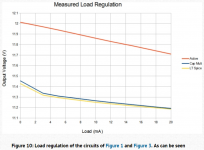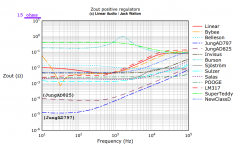I've stumbled across this article twice now in the last 6mo, find it interesting..
Simple circuits reduce regulator noise floor | EDN
Anybody actually try something like this?
I've noticed on a diy analyzer/gen that heaps of capacitance on the 5v dac supply helps with distortion. Even an increase from 1000u to 6800u made a measurable difference. Almost a stupid amount of cap at that point. Considered trying something in the article.
More for play than anything else...
Simple circuits reduce regulator noise floor | EDN
Anybody actually try something like this?
I've noticed on a diy analyzer/gen that heaps of capacitance on the 5v dac supply helps with distortion. Even an increase from 1000u to 6800u made a measurable difference. Almost a stupid amount of cap at that point. Considered trying something in the article.
More for play than anything else...
Last edited:
edn articles are usually reliable. From professional contributors.
Yeah, some good articles on the site.
Interesting circuit. Theory is there, just wondering if anybody had tried it.
I use capacitance multiplier in my amplifier.
Diode zener regulator with noise reduction, I use it in Another Inverting LM1875
Diode zener regulator with noise reduction, I use it in Another Inverting LM1875
I have one question about regulator noise. There are many low noise regulators like TAR5SXX with 10 microVrms. But if I compare those values with low noise OPamp on the same bandwidth, they are inferior to OPamp by ten times.
The only low noise regulator which can compete with OPamp I know is LT3042 (almost 1 microVrms.). I wonder where the difference come from. I think it's not so difficult for a manufacturer to make a regulator as same noise as OP amp. Is this incorrect?
The only low noise regulator which can compete with OPamp I know is LT3042 (almost 1 microVrms.). I wonder where the difference come from. I think it's not so difficult for a manufacturer to make a regulator as same noise as OP amp. Is this incorrect?
Thank you for your reply.That's incorrect. You compare the amplifier only, but must compare (amplifier+reference) to the regulator. The reference is the harder part.
cheers, Gerhard
I think it is a terrible idea to increase the regulator's output impedance to 15 ohms.
Output Impedance = slope = delta_V / delta_I = 0.3V / 0.02A = 15 ohms
I think Walt Jung had much better ideas for achieving ultra low noise voltage regulators without compromising output impedance:
I've copied the Measured Output Impedance graph from the Linear Audio downloads page, and added a line at Zout=15 ohms. As you can see, this is much much worse than any of the tested regulators, and six orders of magnitude (a factor of a million) worse than the Jung design.
_
Output Impedance = slope = delta_V / delta_I = 0.3V / 0.02A = 15 ohms
I think Walt Jung had much better ideas for achieving ultra low noise voltage regulators without compromising output impedance:
- Build the regulator from a zener diode, an opamp, and a series pass transistor
- Choose the extremely low noise zener diode "LM329"
- Use an RC lowpass filter to reduce its noise still further
- Apply the noise-reduced signal to the Vref terminal of the opamp
_
Attachments
Hi,
@xx3stkm
Keep in mind that the noise figures of Regs using a reference voltage source apply only to the lowest output voltage of the reg, which is the reference voltage.
Higher voltages require the error amplifier to have some (noise) gain.
Hence the noise for a high output voltage is alot higher than for a low output voltage.
The LT3042 (and the stronger LT3045) generate a 'reference voltage' by the voltage drop of a external reference-setting resistor that is fed by a ccs.
A paralleled cap shunts away noise from the resistor.
Since the ccs's current is small, the setting resistor value is quite large.
Hence even a small parallel cap achieves a low corner frequency for noise filtering.
The 'reference voltage' is then buffered, adding only the lowest noise gain from the error amplifier.
That way even high output voltages can be generated with low noise.
Besides, the buffer has of course a much greater bandwidth than a typical error amplifier.
That makes the LT30xx even more interesting
jauu
Calvin
@xx3stkm
Keep in mind that the noise figures of Regs using a reference voltage source apply only to the lowest output voltage of the reg, which is the reference voltage.
Higher voltages require the error amplifier to have some (noise) gain.
Hence the noise for a high output voltage is alot higher than for a low output voltage.
The LT3042 (and the stronger LT3045) generate a 'reference voltage' by the voltage drop of a external reference-setting resistor that is fed by a ccs.
A paralleled cap shunts away noise from the resistor.
Since the ccs's current is small, the setting resistor value is quite large.
Hence even a small parallel cap achieves a low corner frequency for noise filtering.
The 'reference voltage' is then buffered, adding only the lowest noise gain from the error amplifier.
That way even high output voltages can be generated with low noise.
Besides, the buffer has of course a much greater bandwidth than a typical error amplifier.
That makes the LT30xx even more interesting
jauu
Calvin
Thank you Calvin. I appreciate your reply. I have understood what you mean and the "magic" LTC used. What I couldn't make sense so far is that CCS also has noise (6nArms) and it was amplified by the setting register. So, output noise becomes large according to output voltage even if the buffer gain is always 0dB.
I know bypassing the setting register with a capacitor also decreases the noise voltage. But also this is not so effective enough to cancel the increasing noise voltage from my experience.
What I have overlooked is the source impedance of CCS and the value of the setting register which are much higher than usual voltage reference. It means bypassing effect is very powerful than usual bypass one. I usually use a bypass condenser for voltage source which has low impedance. That's why LTC claims low noise from 1.3V to 15V.
I know bypassing the setting register with a capacitor also decreases the noise voltage. But also this is not so effective enough to cancel the increasing noise voltage from my experience.
What I have overlooked is the source impedance of CCS and the value of the setting register which are much higher than usual voltage reference. It means bypassing effect is very powerful than usual bypass one. I usually use a bypass condenser for voltage source which has low impedance. That's why LTC claims low noise from 1.3V to 15V.
- Status
- This old topic is closed. If you want to reopen this topic, contact a moderator using the "Report Post" button.
- Home
- Amplifiers
- Power Supplies
- regulator noise

